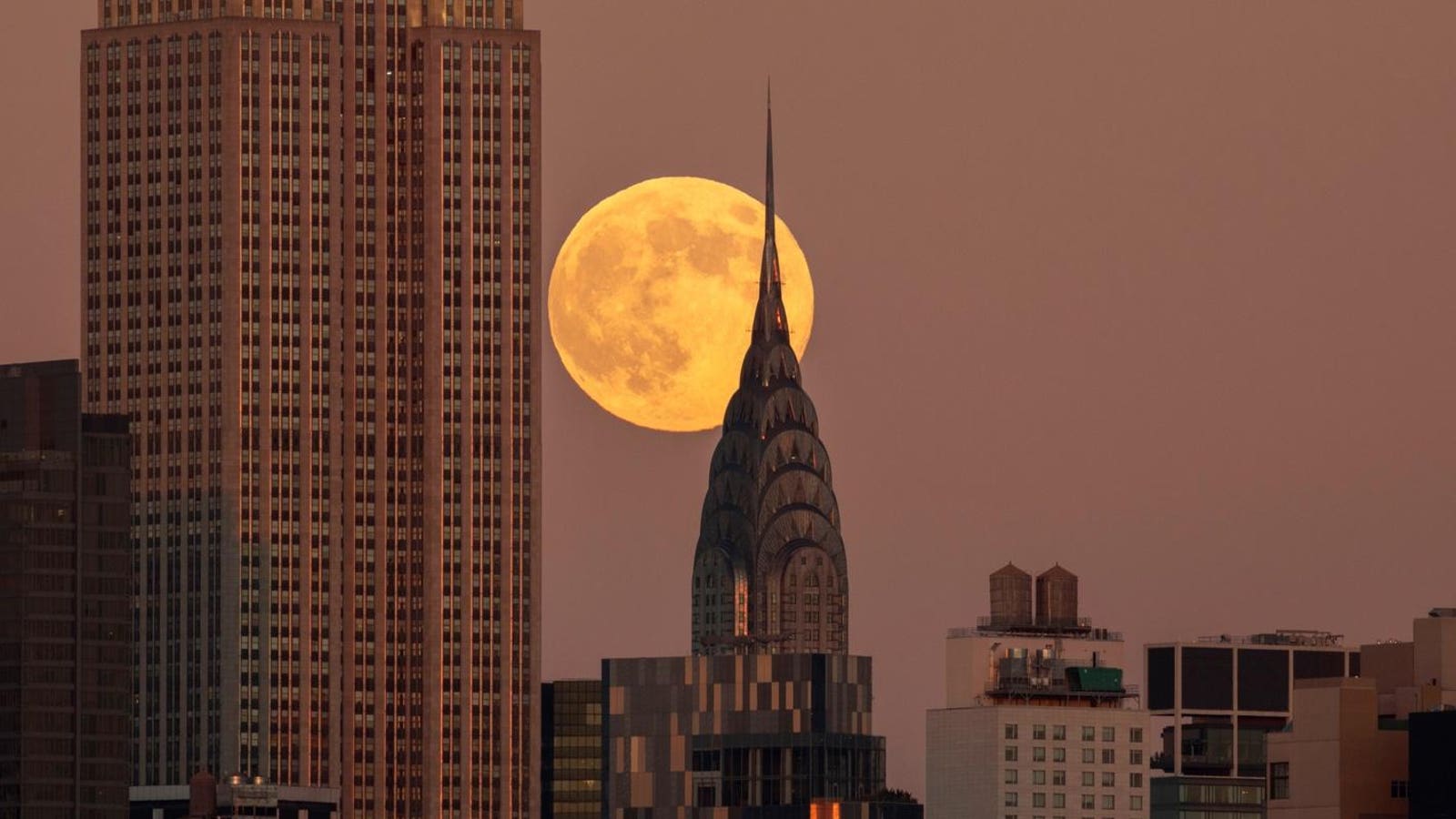Topline
The full beaver moon — the second of fall in the Northern Hemisphere —will turn full on Wednesday, Nov. 5, but it will be best seen from North America during dusk on Thursday, Nov. 6. Named for the beavers that build their dams at night in November in North America, this moon is significant for being not only the biggest full moon of 2025 — a “supermoon” — but also the biggest since 2019. It’s the second of four supermoons that round out 2025 and begin 2026.
The full Beaver Supermoon rises behind the Chrysler Building and the Empire State Building in New York City as the sun sets on November 15, 2024, as seen from Jersey City, New Jersey. (Photo by Gary Hershorn/Getty Images)
Getty ImagesKey Facts
The beaver moon will turn full at 8:20 a.m. EST on Wednesday, Nov. 5. It will look full the night before and the night after, but the best time to watch it rise in North America will be at moonrise during dusk on Thursday, Nov. 6, when it will appear on the eastern horizon shortly after sunset.
According to EarthSky, November’s full moon can be known as the hunter’s, frosty and beaver moon. Cultural and seasonal names for the full moon vary hugely across the world.
The beaver moon is 2025’s second supermoon. The moon’s orbital path around Earth is slightly elliptical, so each month, there’s a point when it’s farthest away (apogee) and closest (perigee). If a full moon coincides with a perigee, it’s closer to Earth and bigger in the night sky, which is also known as a supermoon. The beaver moon will be 100%-lit just nine hours after its perigee.
A supermoon is defined as one that is 10% closer than the average distance. The moon’s average distance from Earth is 238,900 miles (384,472 km). 221,817 miles (356,980 kilometers), it will be the closest of the year, so the biggest and brightest. It will be the closest since Tuesday, February 19, 2019’s full moon, which was 221,681 miles (356,761 kilometers) distant. A “Christmas Supermoon” on Dec. 24, 2026, will see perigee take the moon within 221,611 miles (356,649 kilometers) of Earth.
A full moon always looks at its best when it first appears above the eastern horizon during dusk. The sight is at its best when the moon rises shortly after sunset, which it does this month in North America, with the beaver moon rising about 30 minutes after the sun goes down.
Best Time To See The Full ‘beaver Moon’ Rise
To see the full beaver moon at its best, find an elevated location, an open field or an east-facing coastline with a clear view of the eastern horizon. To find the best time to see it appear from where you are, consult a moonrise calculator. Here are some sample times :
New York: sunset at 4:47 p.m. EST, moonrise at 5:19 p.m. EST on Thursday, Nov. 6.Los Angeles: sunset at 4:56 p.m. PST, moonrise at 4:57 p.m. PST on Thursday, Nov. 6. London: sunset at 4:24 p.m. GMT, moonrise at 5:06 p.m. GMT on Friday, Nov. 7.Why A ‘supermoon’ Looks So Large
Moonrise is the best time to be subjected to the “moon illusion” during which the moon appears larger than usual. The effect is maximized for a supermoon, which means the moon is as big as it gets in the sky, about 10% larger in the case of the beaver moon this month. An optical illusion caused by the human brain, trees, buildings and mountains around the moon somehow accentuate its size in the mind of humans. According to NASA, there’s no satisfying scientific explanation for exactly why we perceive the moon as larger when it appears close to the horizon.
Background
The beaver moon is the eleventh of 12 full moons in 2025. A solar year is 365.24 days, while a lunar year is around 354.37 days, so sometimes there are 13 full moons in one calendar (solar) year — as in 2023 and next in 2028. Of the 12 full moons in 2025, three are “supermoons” — of which the beaver moon is the biggest — with two “blood moon” total lunar eclipses (the first happened on March 13-14 and the second on Sept. 7-8). The next full moon will be the cold moon, the year’s second-biggest “supermoon,” on Thursday, Dec. 4, 2025.
Further ReadingForbesSee Two ‘Blood Moons,’ Three ‘Supermoons’ And The Biggest Full Moon Since 2019: The Moon In 2025By Jamie CarterForbesPerseid Meteor Shower 2025: Why You Need To Change Your PlansBy Jamie CarterForbesThese Are The Meteor Showers Not To Miss In 2025 — By An ExpertBy Jamie Carter

